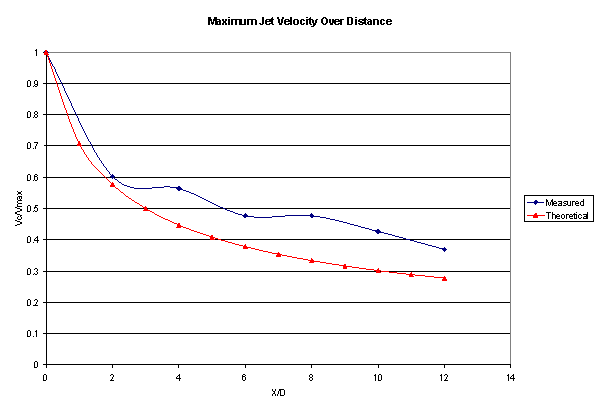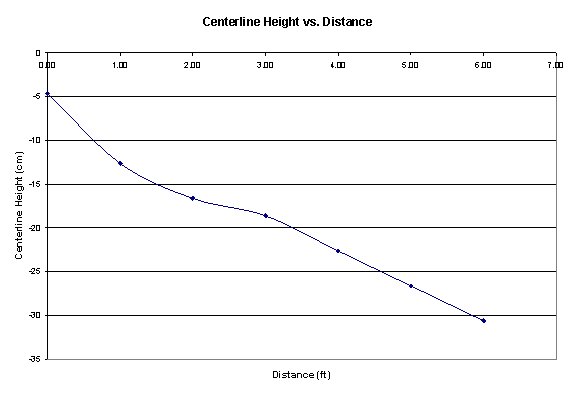







Testing Results/Analysis - Vehicle Movement System
|
To study the decay of the jet velocity over distance, velocity profiles of the jet were examined at specified locations downstream of the vent exit. A pitot-static probe was used to obtain pressure measurements of the jet, because of its high level of accuracy. The fan assembly was placed at a designated position and the pitot probe was placed directly at the center of the vent exit. The fan was turned on and the pressure reading at the center of the vent exit was obtained by means of a digital pressure meter. The pitot probe was then moved upwards in one centimeter increments and the corresponding pressure readings were recorded. This process was followed until the upper boundary of the jet had been found. The same procedure was followed on the lower portion of the jet. From these pressure readings, the vertical velocity profile at the exit of the vent was calculated. Following the same procedures, the vertical velocity profiles were calculated at one foot intervals to a maximum distance of six feet. A maximum distance of six feet was chosen because it is the half scale distance to the gunner position in the actual system. This gunner position is the primary target of the vent system.
The analysis of the data obtained from the testing of the Vehicle Movement System prototype produced the flow profile seen in the figure below. This figure shows how the air flow developed over the testing distance. Both the spread of the jet and its relative velocity can be seen for the different testing locations. It can be seen in this figure that there was a negative velocity obtained at the top of the vent exit. This is most likely due to a large turbulent formation occurring from the sharp 90 degree turn of the duct system. This sharp turn was caused by a mass flow separation, which introduced vortices into the air flow.
** Note: X-axis distance is not to scale**
The theoretical spread rate of a plane rectangular jet is 0.11. This theoretical spread rate was compared to the experimental spread rate of the air flow from the vent. From the spread rate data collected from the experiment, the spread rate from the vent of the prototype was 0.1181 for the flow above the centerline velocity and 0.1083 below the centerline velocity. The first two points were disregarded for the spread due to their deviation from the rest of the points. It is most likely that this deviation is due to the large turbulent area found at the top of the jet exit.
As a result, the spread rate of the air flow from the prototype is very similar to the expected theoretical data. The flow above the centerline velocity had a percent error of 7.36% and the flow below the centerline velocity had a percent error of 1.54%.
From the test data the centerline velocity was plotted against the distance from the vent exit. The maximum velocity of the air flow at the vent exit was 42.76 mph and it decreased to a velocity of 15.79 mph six feet away from the vent exit. This can be seen in the figure below.
Theoretically, the velocity of a turbulent plane jet decreases as the distance from the jet increases at a rate of x-1/2, where x is the half width of the jet. The velocity vs. distance graph shows that the velocity of the air flow decreases at a rate similar to x-1/2.
This graph is in non-dimensional units and can be scaled to any size model. Assuming that the actual system follows this model, the centerline velocity at the vent exit should be approximately 115 mph in order for the target to attain 40 mph winds. With no losses, the average velocity exiting the actual vent system would be 163 mph. Assuming this is the centerline velocity, the duct system must be at least 72% efficient for this fan to reach the specified wind requirements.
For a turbulent rectangular jet, the potential core vanishes at a distance of about one diameter from the exit. As the distance from the vent increases, the theoretical profile of the velocity develops a flatter shape. Velocity profiles for the prototype were developed at 0, 12, 24, 36, 48, 60, and 72 inches away from the exit of the vent. Based on the velocity profile data collected from the experiment, which is referenced in Appendix F, the velocity profiles developed a flatter shape as the distance from the vent increased. As a result, the velocity profiles developed in the experiment followed the theoretical trend.
It was also observed from the data collected that the centerline height of the velocity drops as the distance from the exit of vent increases. The total drop in height of this centerline velocity at a distance of six feet from the exit of the vent, shown in Figure 6.6, was 26 cm.
After analyzing the data acquired from the Vehicle Movement System testing, conclusions were made in order to help improve the originally proposed design. The prototype model experienced a mass flow separation prior to the exit of the vent. This flow separation led to a lower exit velocity and a non-uniform flow profile. Due to the fact that the prototype had a sharp 90 degree bend in the duct system, it is likely that it experienced more turbulence than the actual design would. The actual designed system incorporated a rounded turn, which would help reduce some of incurred turbulence. In order to further reduce the amount of turbulence created by the system, guide fins could be added to help direct the flow around the 90 degree turn to the vent exit. Extending the length of the vent exit would also help allow the flow to redevelop before it leaves the vent exit. A directional vent could also be added to the vent exit in order to help direct the flow to the desired target location. |
Home
Page
| Team
Members |
Problem Scope
| Design |
Fabrication
|
Testing
|
Deliverables |
|
|
|||||
|
|
|||||






